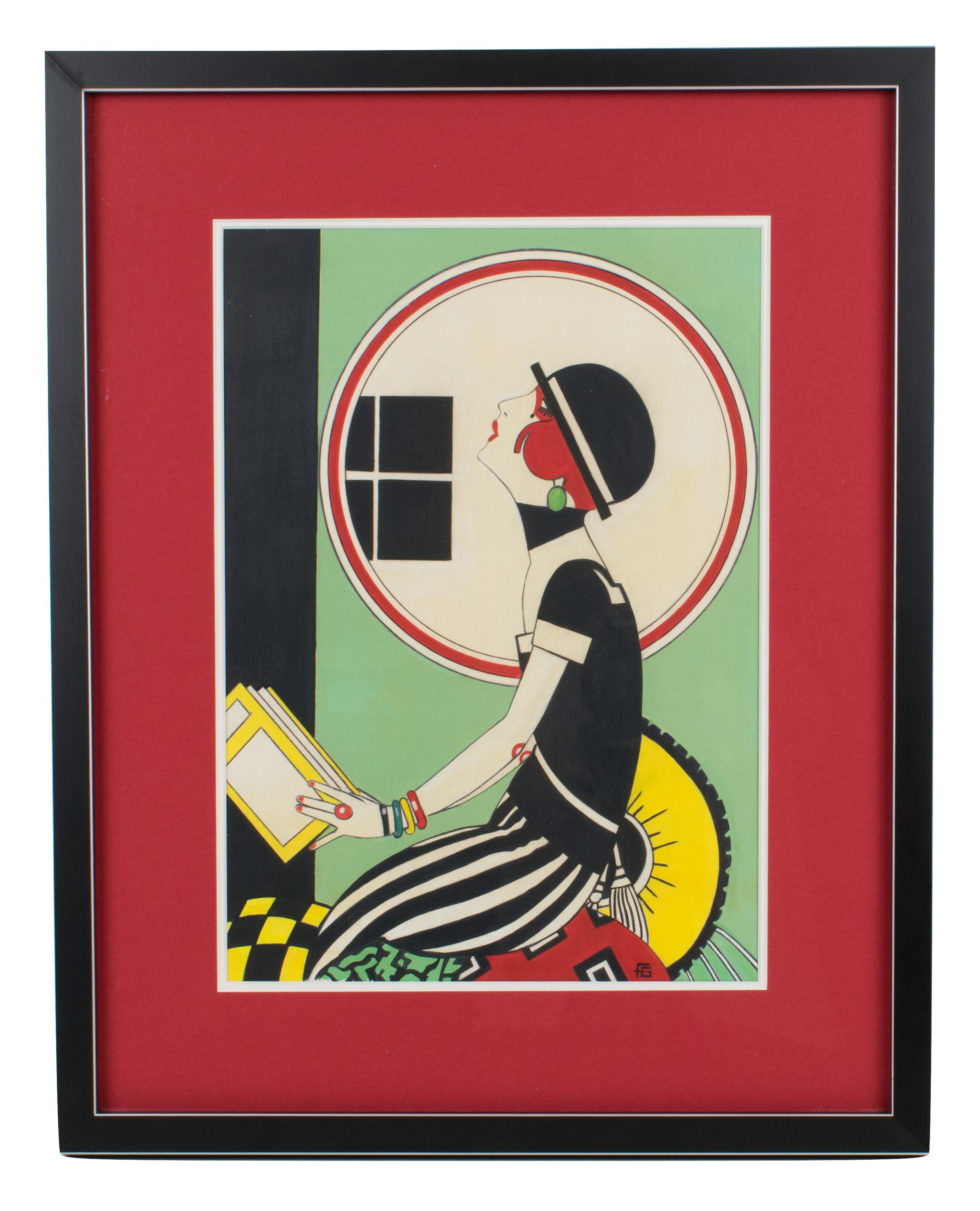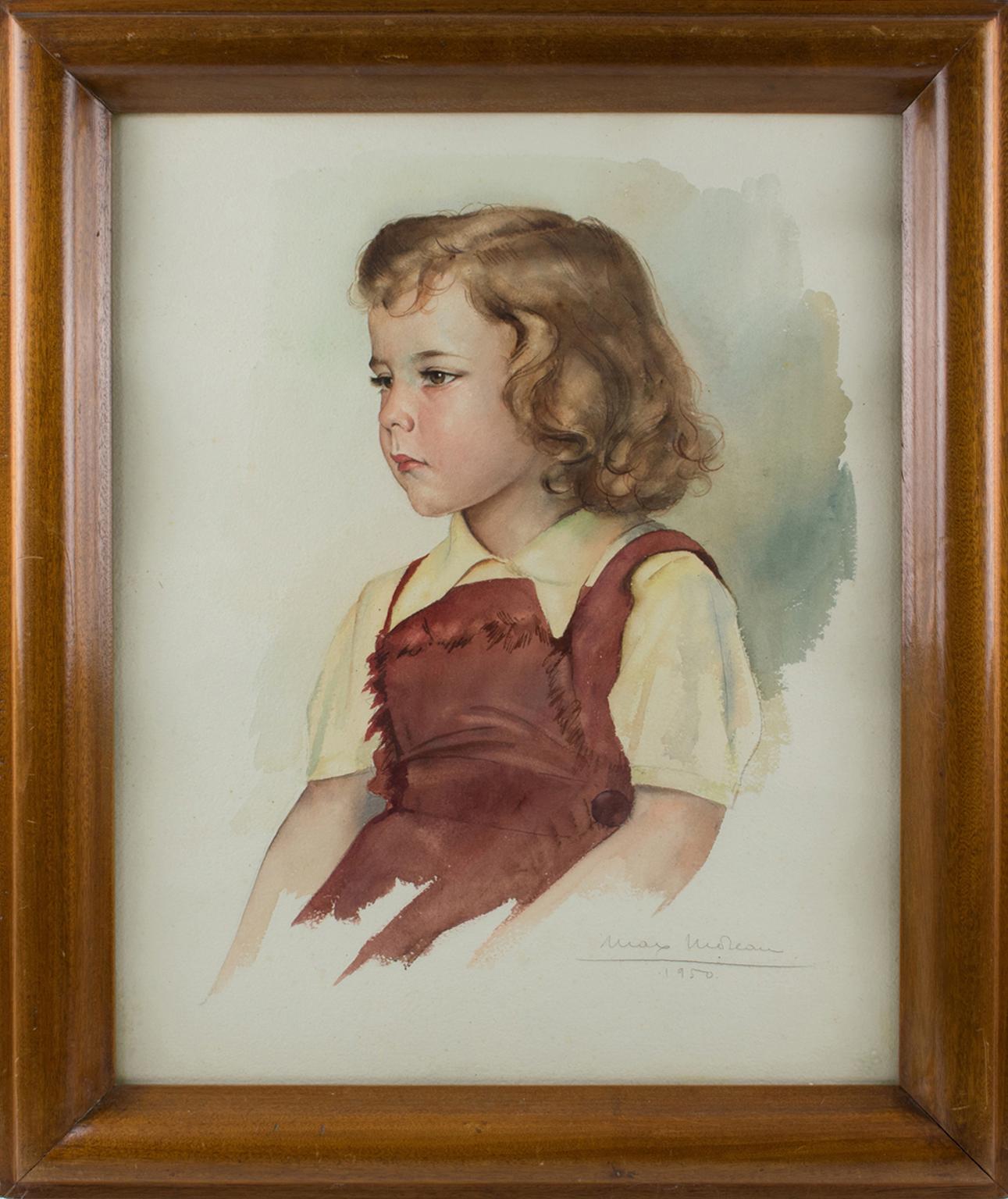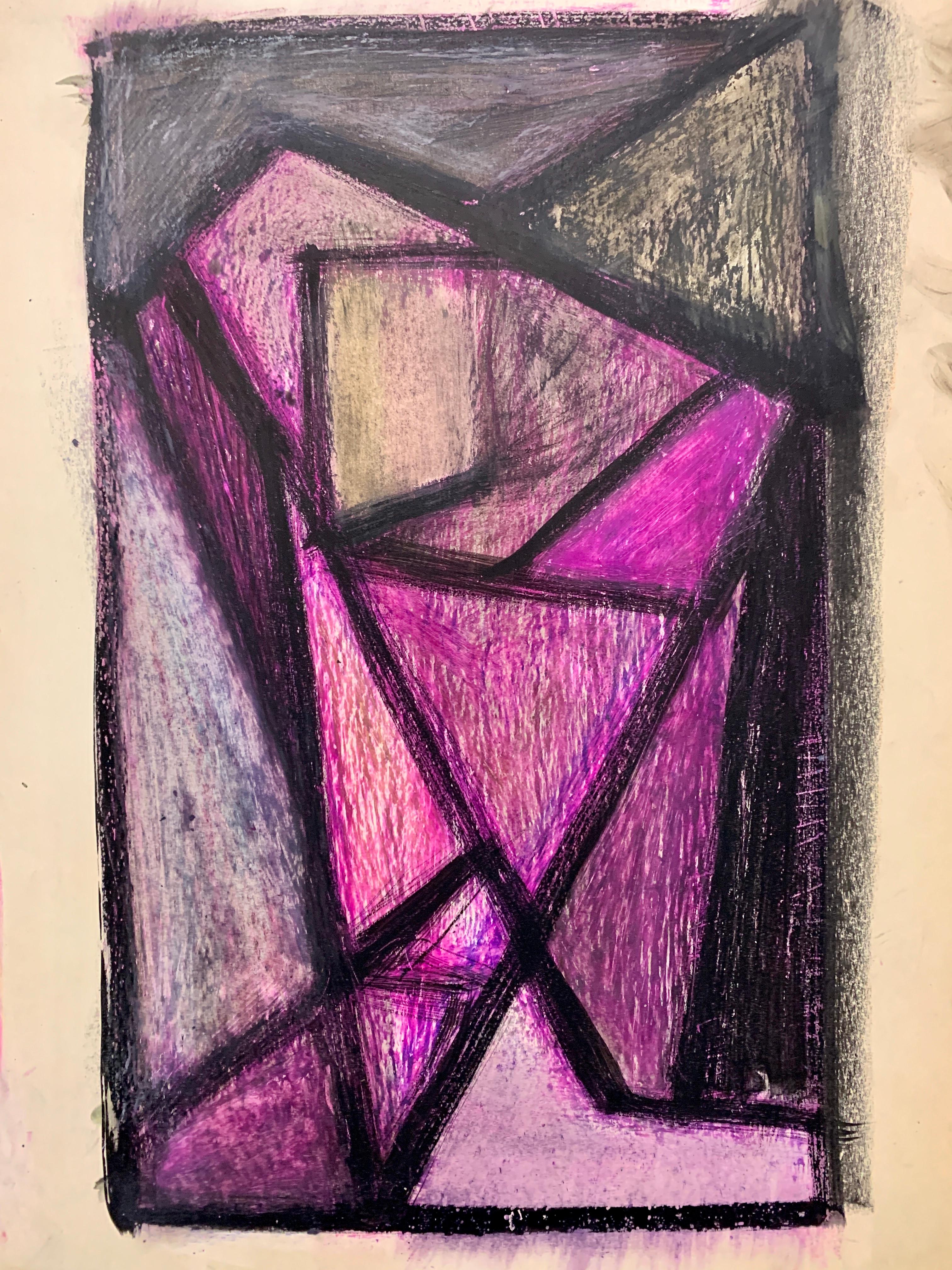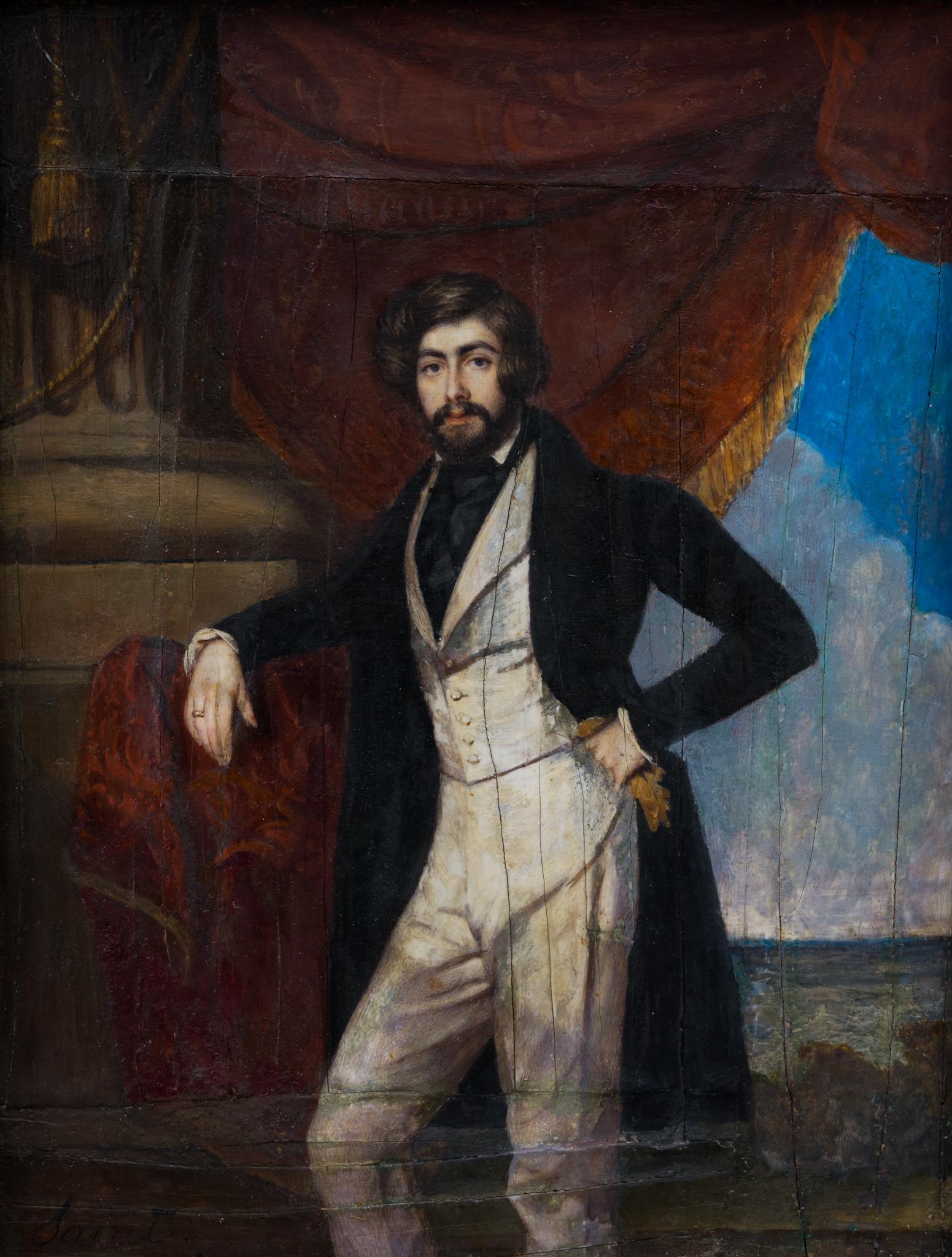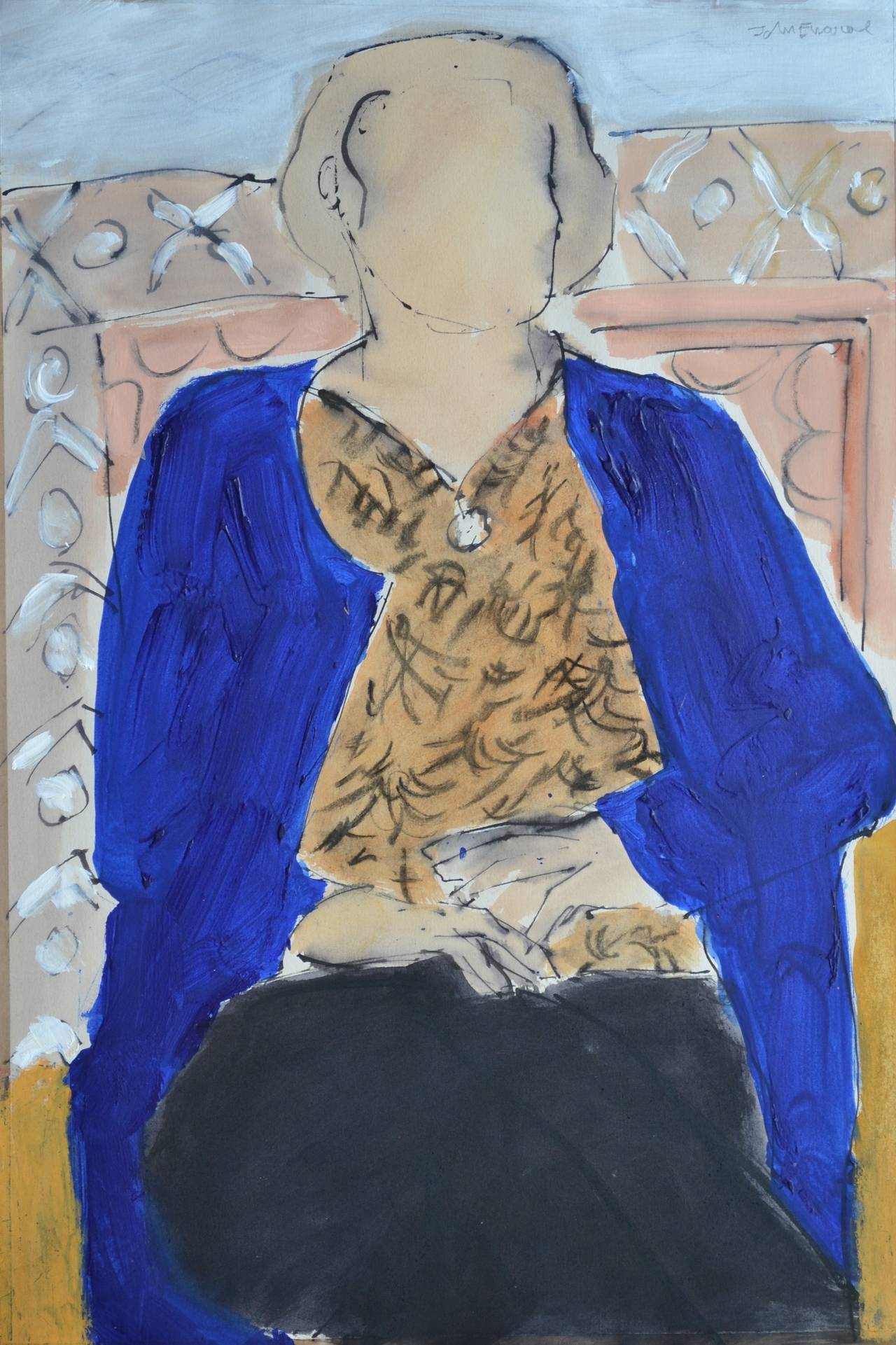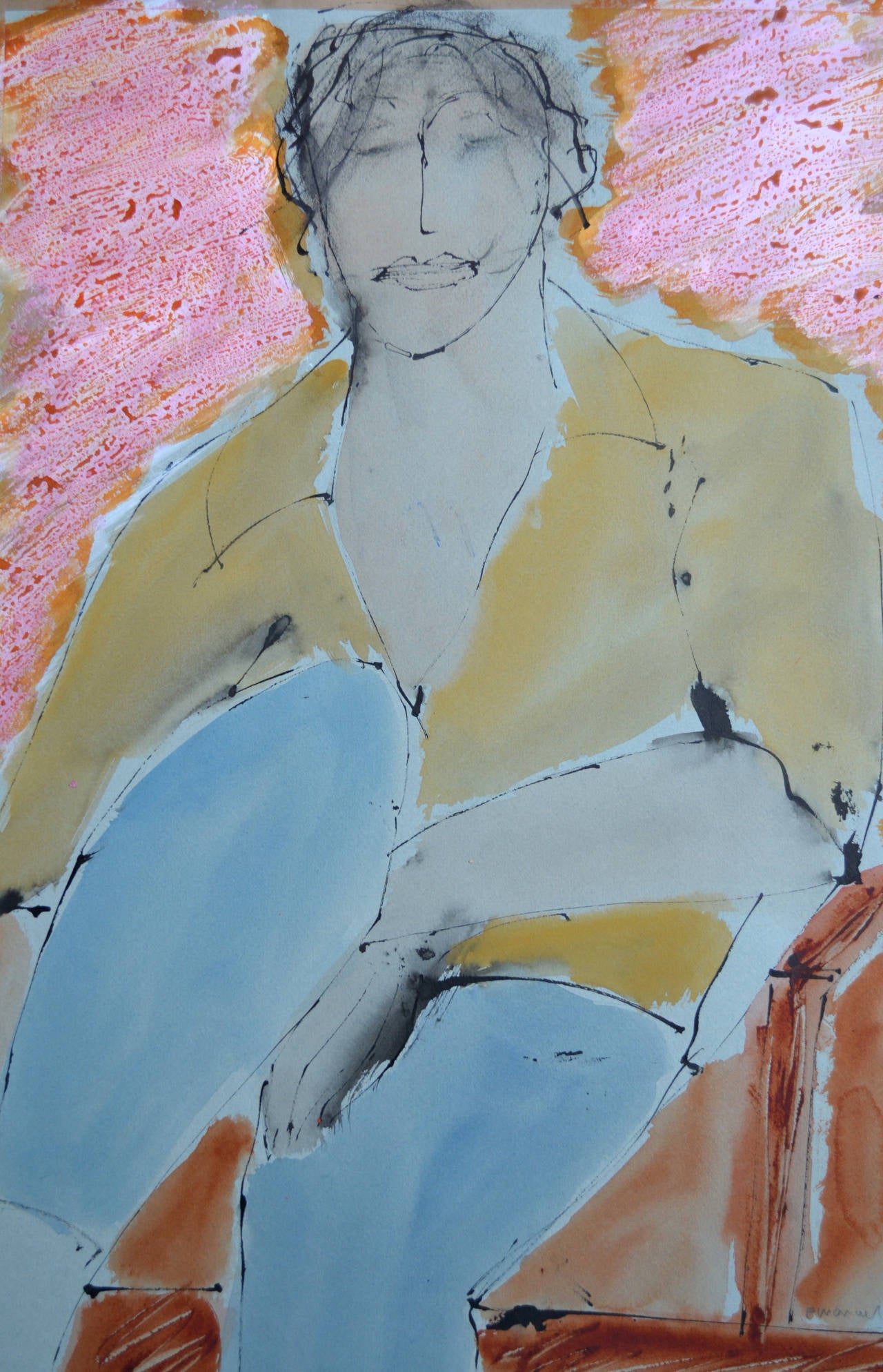Items Similar to Beautiful Woman watercolor painting by Robert Philipp
Want more images or videos?
Request additional images or videos from the seller
1 of 7
Robert PhilippBeautiful Woman watercolor painting by Robert Philipp
About the Item
A sensitive portrait beautifully rendered in watercolor and gouache.
Mid century. I am guessing from the 1940s
it is not dated.
Robert Philipp (February 2, 1895 – November 22, 1981) was an American painter influenced by Impressionism and Post-Impressionism, and known for his nudes, still lifes, and portraits of attractive women and Hollywood stars. Noted art critic Henry McBride called Philipp one of America's top six painters of his generation. He was an instructor of painting at the Art Students League of New York for 33 years. WPA Era. Philipp was Secretary of the National Academy of Design, and National Academician, Benjamin Franklin Fellow, Royal Society of Arts in London. He was married to model and fellow artist Rochelle ("Shelly") Post, who frequently posed for him until her death in 1971. His compositions and painting style have been compared to the art of Edgar Degas and Pierre-Auguste Renoir. Philip won prizes in most of the important exhibitions of his time, and his paintings are in numerous museums and important private collections.
In 1940, Philipp was invited to Los Angeles by Hollywood mogul Louis B. Mayer to paint portraits of Metro-Goldwyn-Mayer movie stars. The same year, Walter Wanger, producer of The Long Voyage Home, directed by John Ford and based on plays by Eugene O'Neill, contracted with Reeves Lewenthal, head of the Associated American Artists gallery in Manhattan, to bring nine well-known artists to the set and paint scenes from the movie and portraits of the actors in character. The artists included Robert Philipp, Thomas Hart Benton, Grant Wood, Ernest Fiene, George Schreiber, Luis Quintanilla, George Biddle, Raphael Soyer, and James Chapin. Life magazine featured the 12 canvases produced, which were exhibited in New York and in 23 museums around the country. While on the West Coast, Philipp painted portraits of celebrities associated with the Golden Age of Hollywood, including Clark Gable, Shirley Temple, Margaret Sullavan, Ian Hunter, Thomas Mitchell, and Mayer's daughter, Edith Mayer Goetz, wife of William Goetz, who was a co-owner of 20th Century Fox.
Robert Philipp won prizes in most of the important exhibitions of his time including the National Academy of Design, New York, Second Hallgarten Prize (1922); the Chicago Art Institute, First Prize and Logan Gold Medal (1936); Carnegie International, First Honorable Mention (1937); the Corcoran Gallery, Washington, D.C., Corcoran Silver Medal and Clarke Prize (1939); International Business Machine Corporation, Honorary Award and Medal for Distinction and Contribution to American Art (1939); Academician, National Academy of Design (1945); the National Academy of Design, Thomas B. Clark Prize (1947); the National Academy of Design, Ranger Food Purchase Award (1950); the National Academy of Design, First Altman Prize (1951); Laguna Beach Art Association Festival, First Prize (1951); the Art Directors ClubMedal of Merit (1954); the National Arts Club, New York, Gold Medal (1955); Allied Artists of America, Bronze Medal (1958); Audubon Artists, Emily Lowe Award (1959); Allied Artists of America Prize (1960); the National Academy of Design, Henry Ward Ranger Purchase Award, Benjamin Altman Prize (1962); the Salmagundi Club, New York, Prize (1960); the National Academy of Design, Benjamin Altman Prize, Gloria Layton Memorial Prize (1966); and the American Watercolor Society, William Church Osborne Award (1967).
Paintings by Robert Philipp can be found in numerous public collections around the United States including those of the Akron Art Institute, Ohio; University of Arizona, Tucson; Brooklyn Museum, New York; Columbus Museum of Art, Georgia; Corcoran Gallery, Washington, D.C.; Dallas Museum of Fine Arts, Texas; Davenport Municipal Art Gallery, Iowa; Dayton Art Institute, Ohio; Encyclopedia Britannica, Chicago; IBM Corporation; Los Angeles County Museum of Art, Los Angeles; University of Illinois, Urbana; Telfair Museum of Art, Savannah, Georgia; and The High Museum of Art, Atlanta, Georgia.
- Creator:Robert Philipp (1895-1981, American)
- Dimensions:Height: 17.5 in (44.45 cm)Width: 14.5 in (36.83 cm)
- Medium:
- Period:
- Condition:picture is excellent. original frame can use replacing.
- Gallery Location:Surfside, FL
- Reference Number:1stDibs: LU38210434962
About the Seller
4.9
Platinum Seller
These expertly vetted sellers are 1stDibs' most experienced sellers and are rated highest by our customers.
Established in 1995
1stDibs seller since 2014
1,550 sales on 1stDibs
Typical response time: 1 hour
- ShippingRetrieving quote...Ships From: Surfside, FL
- Return PolicyA return for this item may be initiated within 3 days of delivery.
More From This SellerView All
- Judaica Pastel Portrait Rabbi Painting WPA Era Artist, Social RealistBy Bernard GussowLocated in Surfside, FLBernard Gussow 1881 -1957 Bernard Gussow was active/lived in New York, New Jersey / Russian Federation. Bernard Gussow is known for genre, landscape, figure, interior paintings. Ber...Category
1940s American Realist Portrait Drawings and Watercolors
MaterialsOil Pastel
- Rare Modernist Hungarian Rabbi Pastel Drawing Gouache Painting Judaica Art DecoBy Hugó ScheiberLocated in Surfside, FLRabbi in the synagogue at prayer wearing tallit and tefillin. Hugó Scheiber (born 29 September 1873 in Budapest – died there 7 March 1950) was a Hungarian modernist painter. Hugo Scheiber was brought from Budapest to Vienna at the age of eight where his father worked as a sign painter for the Prater Theater. At fifteen, he returned with his family to Budapest and began working during the day to help support them and attending painting classes at the School of Design in the evening, where Henrik Papp was one of his teachers. He completed his studies in 1900. His work was at first in a post-Impressionistic style but from 1910 onward showed his increasing interest in German Expressionism and Futurism. This made it of little interest to the conservative Hungarian art establishment. However, in 1915 he met the great Italian avant-gardist Filippo Tommaso Marinetti and the two painters became close friends. Marinetti invited him to join the Futurist Movement. The uniquely modernist style that he developed was, however, closer to German Expressionism than to Futurism and eventually drifted toward an international art deco manner similar to Erté's. In 1919, he and his friend Béla Kádar held an exhibition at the Hevesy Salon in Vienna. It was a great success and at last caused the Budapest Art Museum to acquire some of Scheiber's drawings. Encouraged, Scheiber came back to live in Vienna in 1920. A turning point in Scheiber's career came a year later, when Herwarth Walden, founder of Germany's leading avant-garde periodical, Der Sturm, and of the Sturm Gallery in Berlin, became interested in Scheiber's work. Scheiber moved to Berlin in 1922, and his paintings soon appeared regularly in Walden's magazine and elsewhere. Exhibitions of his work followed in London, Rome, La Paz, and New York. Scheiber's move to Germany coincided with a significant exodus of Hungarian artists to Berlin, including Laszlo Moholy-Nagy and Sandor Bortnyik. There had been a major split in ideology among the Hungarian avant-garde. The Constructivist and leader of the Hungarian avantgarde, Lajos Kassák (painted by Hugó Scheiber in 1930) believed that art should relate to all the needs of contemporary humankind. Thus he refused to compromise the purity of his style to reflect the demands of either the ruling class or socialists and communists. The other camp believed that an artist should be a figurehead for social and political change. The fall out and factions that resulted from this politicisation resulted in most of the Hungarian avant gardists leaving Vienna for Berlin. Hungarian émigrés made up one of the largest minority groups in the German capital and the influx of their painters had a significant effect on Hungarian and international art. Another turning point of Scheiber's career came in 1926, with the New York exhibition of the Société Anonyme, organized by Katherine Dreier. Scheiber and other important avant garde artists from more than twenty-three countries were represented. In 1933, Scheiber was invited by Marinetti to participate in the great meeting of the Futurists held in Rome in late April 1933, Mostra Nazionale d’Arte Futurista where he was received with great enthusiasm. Gradually, the Hungarian artists began to return home, particularly with the rise of Nazism in Germany. Kádar went back from Berlin in about 1932 and Scheiber followed in 1934. He was then at the peak of his powers and had a special flair in depicting café and cabaret life in vivid colors, sturdily abstracted forms and spontaneous brush strokes. Scheiber depicted cosmopolitan modern life using stylized shapes and expressive colors. His preferred subjects were cabaret and street scenes, jazz musicians, flappers, and a series of self-portraits (usually with a cigar). his principal media being gouache and oil. He was a member of the prestigious New Society of Artists (KUT—Képzőművészek Új Társasága)and seems to have weathered Hungary's post–World War II transition to state-communism without difficulty. He continued to be well regarded, eventually even receiving the posthumous honor of having one of his images used for a Russian Soviet postage stamp (see image above). Hugó Scheiber died in Budapest in 1950. Paintings by Hugó Scheiber form part of permanent museum collections in Budapest (Hungarian National Museum), Pecs (Jannus Pannonius Museum), Vienna, New York, Bern and elsewhere. His work has also been shown in many important exhibitions, including: "The Nell Walden Collection," Kunsthaus Zürich (1945) "Collection of the Société Anonyme," Yale University Art Gallery, New Haven, Connecticut (1950) "Hugó Scheiber: A Commemorative Exhibition," Hungarian National Museum, Budapest (1964) "Ungarische Avantgarde," Galleria del Levante, Munich (1971) "Paris-Berlin 1900-1930," Centre Georges Pompidou, Paris (1978) "L’Art en Hongrie, 1905-1920," Musée d’Art et l’Industrie, Saint-Etienne (1980) "Ungarische Avantgarde in der Weimarer Republik," Marburg (1986) "Modernizmus," Eresz & Maklary Gallery, Budapest (2006) "Hugó Scheiber & Béla Kádár," Galerie le Minotaure, Paris and Tel Aviv (2007) Hugó Scheiber's paintings continue to be regularly sold at Sotheby's, Christie's, Gillen's Arts (London), Papillon Gallery (Los Angeles) and other auction houses. He was included in the exhibition The Art Of Modern Hungary 1931 and other exhibitions along with Vilmos Novak Aba, Count Julius Batthyany, Pal Bor, Bela Buky, Denes Csanky, Istvan Csok, Bela Czobel, Peter Di Gabor, Bela Ivanyi Grunwald, Baron Ferenc Hatvany, Lipot Herman, Odon Marffy, C. Pal Molnar...Category
Early 20th Century Modern Figurative Paintings
MaterialsPaper, Charcoal, Pastel, Watercolor, Gouache
- Abstract Houses and Faces Ink Drawing and Watercolor Painting Shtetl JudaicaBy Boris DeutschLocated in Surfside, FLImage size is 11.60" by 9" Boris Deutsch (Lithuanian-American Modernist) was born in Krasnogorsk Lithuania june 4 1892 died in Los Angeles 1978. Entered the polytechnic school in rig...Category
20th Century Modern Portrait Drawings and Watercolors
MaterialsInk, Watercolor
- Chaim Gross Mid Century Mod Judaica Jewish Watercolor Painting Rabbis WPA ArtistBy Chaim GrossLocated in Surfside, FLChaim Gross (American, 1904-1991) Watercolor painting Rabbinical Talmudic Discussion Hand signed 17 x 29 framed, paper 10 x 22 Chaim Gross (March 17, 1904 – May 5, 1991) was an American modernist sculptor and educator. Gross was born to a Jewish family in Austrian Galicia, in the village of Wolowa (now known as Mezhgorye, Ukraine), in the Carpathian Mountains. In 1911, his family moved to Kolomyia (which was annexed into the Ukrainian USSR in 1939 and became part of newly independent Ukraine in 1991). When World War I ended, Gross and brother Avrom-Leib went to Budapest to join their older siblings Sarah and Pinkas. Gross applied to and was accepted by the art academy in Budapest and studied under the painter Béla Uitz, though within a year a new regime under Miklos Horthy took over and attempted to expel all Jews and foreigners from the country. After being deported from Hungary, Gross began art studies at the Kunstgewerbeschule in Vienna, Austria shortly before immigrating to the United States in 1921. Gross's studies continued in the United States at the Beaux-Arts Institute of Design, where he studied with Elie Nadelman and others, and at the Art Students League of New York, with Robert Laurent. He also attended the Educational Alliance Art School, studying under Abbo Ostrowsky, at the same time as Moses Soyer and Peter Blume. In 1926 Gross began teaching at The Educational Alliance, and continued teaching there for the next 50 years. Louise Nevelson was among his students at the Alliance (in 1934), during the time she was transitioning from painting to sculpture. In the late 1920s and early 1930s he exhibited at the Salons of America exhibitions at the Anderson Galleries and, beginning in 1928, at the Whitney Studio Club. In 1929, Gross experimented with printmaking, and created an important group of 15 linocuts and lithographs of landscapes, New York City streets and parks, women in interiors, the circus, and vaudeville. The entire suite is now in the collection of the Philadelphia Museum of Art. Gross returned to the medium of printmaking in the 1960s, and produced approximately 200 works in the medium over the next two decades. For more than sixty years Chaim Gross's art has expressed optimistic, affirming themes, Judaica, balancing acrobats, cyclists, trapeze artists and mothers and children convey joyfulness, modernism, exuberance, love, and intimacy. This aspect of his work remained consistent with his Jewish Hasidic heritage, which teaches that only in his childlike happiness is man nearest to God. In March 1932 Gross had his first solo exhibition at Gallery 144 in New York City. For a short time they represented Gross, as well as his friends Milton Avery, Moses Soyer, Ahron Ben-Shmuel and others. Gross was primarily a practitioner of the direct carving method, with the majority of his work being carved from wood. Other direct carvers in early 20th-century American art include William Zorach, Jose de Creeft, and Robert Laurent. Works by Chaim Gross can be found in major museums and private collections throughout the United States, with substantial holdings (27 sculptures) at the Hirshhorn Museum and Sculpture Garden. A key work from this era, now at the Smithsonian American Art Museum, is the 1932 birds-eye maple Acrobatic Performers, which is also only one and one quarter inch thick. In 1933 Gross joined the government's PWAP (Public Works of Art Project), which transitioned into the WPA (Works Progress Administration), which Gross worked for later in the 1930s. Under these programs Gross taught and demonstrated art, made sculptures that were placed in schools and public colleges, made work for Federal buildings including the Federal Trade Commission Building, and for the France Overseas and Finnish Buildings at the 1939 New York World's Fair. Gross was also recognized during these years with a silver medal at the Exposition universelle de 1937 in Paris, and in 1942, with a purchase prize at the Metropolitan Museum of Art's "Artists for Victory" exhibition for his wood sculpture of famed circus performer Lillian Leitzel. In 1949 Gross sketched Chaim Weizmann, Israeli President, at several functions in New York City where Weizmann was speaking, Gross completed the bust in bronze later that year. Gross returned to Israel for three months in 1951 (the second of many trips there in the postwar years) to paint a series of 40 watercolors of life in various cities. This series was exhibited at the Jewish Museum (Manhattan) in 1953. He also did some important Hebrew medals. In the 1950s Gross began to make more bronze sculptures alongside his wood and stone pieces, and in 1957 and 1959 he traveled to Rome to work with famed bronze foundries including the Nicci foundry. At the end of the decade Gross was working primarily in bronze which allowed him to create open forms, large-scale works and of course, multiple casts. Gross's large-scale bronze The Family, donated to New York City in 1991 in honor of Mayor Ed Koch, and installed at the Bleecker Street Park at 11th street, is now a fixture of Greenwich Village. In 1959, a survey of Gross's sculpture in wood, stone, and bronze was featured in the exhibit Four American Expressionists curated by Lloyd Goodrich at the Whitney Museum of American Art, with work by Abraham Rattner, Doris Caesar, and Karl Knaths. In 1976, a selection from Gross's important collection of historic African sculpture, formed since the late 1930s, was exhibited at the Worcester Art Museum in the show The Sculptor's Eye: The African Art Collection of Mr. and Mrs. Chaim Gross. Gross was elected into the National Academy of Design as an Associate member, and became a full Academician in 1981. In 1984, he was inducted into the American Academy of Arts and Letters, with Jacob Lawrence and Lukas Foss. In the fall of 1991, Allen Ginsberg gave an important tribute to Gross at the American Academy of Arts and Letters, which is published in their Proceedings. In 1994, Forum Gallery, which now represents the Chaim Gross estate, held a memorial exhibition featuring a sixty-year survey of Gross's work.In March 1932 Gross had his first solo exhibition at Gallery 144 in New York City. For a short time they represented Gross, as well as his friends Milton Avery, Moses Soyer, Ahron Ben-Shmuel and others. Gross was primarily a practitioner of the direct carving method, with the majority of his work being carved from wood. Other direct carvers in early 20th-century American art include William Zorach, Jose de Creeft, and Robert Laurent. Works by Chaim Gross can be found in major museums and private collections throughout the United States, with substantial holdings (27 sculptures) at the Hirshhorn Museum and Sculpture Garden. A key work from this era, now at the Smithsonian American Art Museum, is the 1932 birds-eye maple Acrobatic Performers, which is also only one and one quarter inch thick. In 1933 Gross joined the government's PWAP (Public Works of Art Project), which transitioned into the WPA (Works Progress Administration), which Gross worked for later in the 1930s. Under these programs Gross taught and demonstrated art, made sculptures that were placed in schools and public colleges, made work for Federal buildings including the Federal Trade Commission Building, and for the France Overseas and Finnish Buildings at the 1939 New York World's Fair. Gross was also recognized during these years with a silver medal at the Exposition universelle de 1937 in Paris, and in 1942, with a purchase prize at the Metropolitan Museum of Art's "Artists for Victory" exhibition for his wood sculpture of famed circus performer Lillian Leitzel. In 1949 Gross sketched Chaim Weizmann, President of Israel, at several functions in New York City where Weizmann was speaking, Gross completed the bust in bronze later that year. Gross returned to Israel for three months in 1951 (the second of many trips there in the postwar years) to paint a series of 40 watercolors of life in various cities. This series was exhibited at the Jewish Museum (Manhattan) in 1953. In the 1950s Gross began to make more bronze sculptures alongside his wood and stone pieces, and in 1957 and 1959 he traveled to Rome to work with famed bronze foundries including the Nicci foundry. At the end of the decade Gross was working primarily in bronze which allowed him to create open forms, large-scale works and of course, multiple casts. Gross's large-scale bronze The Family, donated to New York City in 1991 in honor of Mayor Ed Koch, and installed at the Bleecker Street Park at 11th street, is now a fixture of Greenwich Village. In 1959, a survey of Gross's sculpture in wood, stone, and bronze was featured in the exhibit Four American Expressionists curated by Lloyd Goodrich at the Whitney Museum of American Art, with work by Abraham Rattner, Doris Caesar, and Karl Knaths. In 1976, a selection from Gross's important collection of historic African sculpture, formed since the late 1930s, was exhibited at the Worcester Art Museum in the show The Sculptor's Eye: The African Art Collection of Mr. and Mrs. Chaim Gross. Gross was elected into the National Academy of Design as an Associate member, and became a full Academician in 1981. In 1984, he was inducted into the American Academy of Arts and Letters, with Jacob Lawrence and Lukas Foss. In the fall of 1991, Allen Ginsberg gave an important tribute to Gross at the American Academy of Arts and Letters, which is published in their Proceedings. In 1994, Forum Gallery, which now represents the Chaim Gross estate, held a memorial exhibition featuring a sixty-year survey of Gross's work. Gross was a professor of printmaking and sculpture at both the Educational Alliance and the New School for Social Research in New York City, as well as at the Brooklyn Museum Art School, the MoMA art school, the Art Student's League and the New Art School (which Gross ran briefly with Alexander Dobkin...Category
Mid-20th Century American Modern Figurative Drawings and Watercolors
MaterialsPaper, Watercolor
- Jerusalemite Yeshiva Scholar, Judaica WatercolorLocated in Surfside, FLJudaica watercolor portrait, Israel, signed l.r.Category
20th Century Modern Portrait Drawings and Watercolors
MaterialsWatercolor
- Old Rabbi Holding a CaneBy David GilboaLocated in Surfside, FLDavid Gilboa (1910-1976). David Gilboa was born in Romania in 1910. He studied at Academy of Fine Art, Bucharest, Romania, during the years of 1927-29. He immigrated to Israel in 193...Category
20th Century Portrait Drawings and Watercolors
MaterialsWatercolor
You May Also Like
- French Art Deco Woman Singing Gouache PaintingLocated in Atlanta, GAA lovely gouache on cardboard painting featuring an Art Deco singer with a typical stylish outfit. The composition is very vibrant, using the contrast of black and white elements ag...Category
1930s Art Deco Portrait Paintings
MaterialsGouache, Board, Cardboard
- Portrait of Young Girl Gouache Painting by Max MoreauBy Max MoreauLocated in Atlanta, GA1950s portrait, gouache on paper painting by Belgian artist Max Moreau (1902 - 1992). A finely detailed portrait of a lovely young girl looking like a good child from the period right after WWII. Moreau captures the sweet expression, soft features, and calm, well-mannered demeanor of that child. Hand-signed and dated on the bottom right corner. The artist demonstrates incredible skill in detailing this portrait with gouache and watercolor. This skill has made his portraits so desirable for international collectors. The painting still has its original elegant mahogany carved frame with glass protection. Measurements: With frame: 25.19 in wide (64 cm) x 30.32 in high (77 cm) x 2.38 in deep (6 cm). Opening view: 19.69 in wide (50 cm) x 24.50 in high (62 cm). Note: Max Leon Moreau (1902 - 1992) Moreau is a highly acclaimed artist born in Belgium. He is best known for his loosely brushed street scenes of Paris, Granada, and North Africa and his revealing portraits of met characters during his foreign travels. Taught to paint by his father, the family moved to Paris, where he made copies of paintings at the Louvre Museum. Later Moreau and his family lived in Tunisia and Morocco before settling in Granada, Spain. Following his death in 1992, his home was converted into a museum dedicated to his life and work. His paintings are internationally collected and appear at auction in major international houses. Max spent his last 30 years living in his Moorish-style house in Granada, which upon his death, was bequeathed to the City of Granada along with the contents of his studio and artwork. The City of Granada has turned his home into a museum showcasing his paintings, studio, and private life. The main building of the Casa Museo Max Moreau houses an exhibition space that takes us on a journey through his most common themes: portraits, still-life, and landscapes, represented through oil paintings, watercolors, and drawings on paper. There is also a series of models for theatre creations that illustrate his interest and relationship to the scenic arts (he was involved in many productions as an actor, playwright, musician, and set designer). The building is an original from the region of Albayzín and is popularly known as Carmen. Does the name come from the Arabic word Karm which means vine, orchard, or garden.?The second building houses his studio, remained untouched: the easel next to the window, a piano with scores, and a collection of oriental objects...Category
1950s Expressionist Portrait Paintings
MaterialsPaper, Gouache
- 1950s "Purple Head" Mid Century Oil and Pastel Portrait Original DrawingBy Donald StacyLocated in Arp, TXDonald Stacy "Purple Head" c.1950s Gouache and oil pastel on paper 13.75" x 17" unframed Unsigned Came from artist's estate Donald Stacy (1925-2008) New Jersey Studied: Newark School of Fine Art The Art Students League Pratt Graphic Arts Center University of Paris 1953-54 University of Aix-en-Provence 1954-55 Faculty: Art Department of the New School Museum of Modern Art School of Visual Arts Stacy Studio Workshop Exhibitions: Grand Central Moderns George Wittenborn The New School Print Exhibitions, Chicago University of Oklahoma Honolulu Museum Monclair Museum Wisconsin State College Louisiana Art Commission Philadelphia Print...Category
Mid-20th Century American Modern Portrait Paintings
MaterialsPaper, Oil Pastel, Gouache
- Portrait of a French Gentleman By Portrait Miniature Artist Daniel SaintBy Daniel SaintLocated in Stockholm, SEDaniel Saint was a prominent French miniaturist who lived between 1778 and 1847. Born in Paris, Saint was the son of a jeweler and initially began his career as an apprentice in his father's workshop. However, he soon discovered his passion for painting and turned his attention to miniatures, which were highly popular in 18th and 19th-century Europe. Saint was a highly skilled artist and quickly gained a reputation for his miniature portraits, which were characterized by their delicate detail and fine brushwork. His works often featured prominent figures from French society, including members of the royal family and high-ranking officials. He also painted portraits of wealthy patrons, many of whom commissioned him to create highly personalized works. Saint's style was highly influenced by the neoclassical movement, which emphasized clarity, simplicity, and rationality. He often used a limited color palette, focusing on soft pastels and muted tones, which helped to accentuate the delicate features of his subjects. His compositions were typically centered around the face, with little background or context to distract from the subject. Despite his success as a miniaturist, Saint was not immune to the changing tastes of the art world. In the mid-19th century, photography began to gain popularity, and many artists who specialized in portraiture found themselves struggling to compete with the speed and accuracy of this new medium. However, Saint continued to work and develop his craft, adapting his style to the changing tastes of his clients and experimenting with new techniques and materials. In addition to his work as a miniaturist, Saint was also a skilled draftsman and created a number of highly detailed and intricate drawings and sketches. He was also known for his use of unconventional materials, such as hair, which he would incorporate into his miniature portraits to add texture and depth. Today, Saint's works are highly prized by collectors and are held in museums and private collections around the world. His legacy as a master of miniature portraiture lives on, and his influence can still be seen in the work of contemporary artists who specialize in this unique and challenging medium. More information: Artist: Daniel Saint (1778-1847) France Title: Portrait of a French Gentleman...Category
Early 19th Century Portrait Drawings and Watercolors
MaterialsGouache
- Sarah Jane In Blue: Contemporary Mixed Media Figurative painting by John EmanuelBy John EmanuelLocated in Brecon, PowysJohn Emanuel embarking on a series of works using new life models. Unusual for a artist who has over the last 40 years only had 3 previous sitters. Now working with Sarah Jane...Category
21st Century and Contemporary Contemporary Portrait Drawings and Waterco...
MaterialsGouache
- In The Pink: Contemporary Mixed Media Figurative painting by John EmanuelBy John EmanuelLocated in Brecon, PowysAnother very pretty mixed media from the studio of this well collected British artist. Image 21" x 15" mounted Originally from Bury, in the North of England, John Emanuel works in ...Category
21st Century and Contemporary Modern Portrait Drawings and Watercolors
MaterialsGouache
